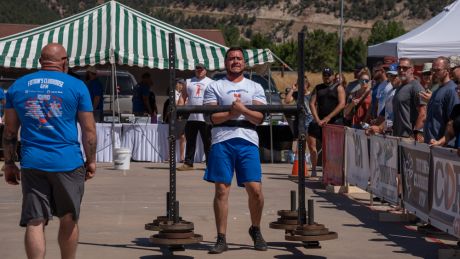How To Do The Zercher Carry
Add this underrated move to your workout routine to build functional strength

Sometimes it’s hard to see how the exercises you do in the gym will translate to any substantial benefit in the real world. That is absolutely not the case with the Zercher carry.
“Simply put, Zercher carries make you really good at carrying something in front of you,” says Will McAuley, strength and conditioning coach at London personal training studio PerformancePro. “Think of carrying a box down a set of stairs on moving day, lifting luggage into an overhead compartment on a plane, or even picking up one of your children!
“The Zercher carry works a whole bunch of different muscles, but mainly it focuses on your trunk, which has to stay stable while you walk so that the weight you’re carrying doesn’t tip to one side. You also get some work for your forearms, biceps, shoulders – mainly the anterior deltoid – and pecs.”
How To Do The Zercher Carry

“The execution of a Zercher carry is simple, but that doesn’t mean that it’s easy!” says McAuley. “You can use any kind of bar for these, but I would recommend using a log-like implement. If you are using a bar, use a bar pad to avoid getting welts in your elbows – you can thank me later.
“Set up the bar or log below elbow height in a rack or a free-standing squat stand, or elevated on a couple of blocks or benches. Squat down slightly, place your elbows directly underneath the bar, and bend your arms around it so that you’re cradling it in your elbow crease. Take a short, sharp breath, brace your trunk and stand up tall. The weight of the bar should be in your arms.
“Once you’re balanced, start walking. When you reach the end of your track, be it ten, 20 or 50 metres, stop, turn – this is the tricky part – and walk back without dropping the bar. Then put it back in the rack.”
See related
- Strongman Training For The Gym
- The Farmer’s Walk Is The Epitome Of Training Efficiently
- What Is Functional Fitness?
Common Mistakes
Walking Too Far
“If it’s your first time with a Zercher carry, don’t go overboard,” says McAuley. “If you try to carry it further than you can, you’ll end up dropping the bar, and have no way to get it back to the start other than rolling it along the floor – not a good look. Start off with a light weight and gradually increase the distance over time.”
Sign up for workout ideas, training advice, reviews of the latest gear and more.
Not Holding The Bar Tight Enough
“People often forget that this is an exercise for your arms and shoulders, as well as your trunk,” says McAule. “If you don’t hold the bar tight, you won’t get the same benefits from the carry, and will lift a lot less weight than you should be able to. Once you’re holding the bar, squeeze it tight with your upper and lower arms and pull it in close to your chest, almost as if someone’s trying to pull it off you. This will recruit more muscles, and allow you to lift more weight and carry it further.”
Setting The Rack Up Too High
“With a heavy carry, as your arms and shoulders get fatigued, you won’t be able to carry the bar as high as you did at the start,” says McAuley. “So the height you picked it up from may be too high to put it back, and you’ll have to drop the bar and start over again. Make sure to set the rack up fairly low, so that no matter how fatigued you are, you’ll always be able to put it back.”
Holding The Bar In Your Hands
“This isn’t a biceps curl or some sort of arm endurance exercise,” says McAuley. “Don’t hold the bar in your hands, because your biceps will fatigue well before anything else. All the weight should be on your forearms, elbows and upper arms, and your hands should just be there to keep the weight close. Don’t worry – you’ll still get a biceps pump this way.”

Nick Harris-Fry is a journalist who has been covering health and fitness since 2015. Nick is an avid runner, covering 70-110km a week, which gives him ample opportunity to test a wide range of running shoes and running gear. He is also the chief tester for fitness trackers and running watches, treadmills and exercise bikes, and workout headphones.
